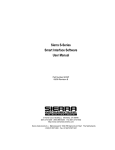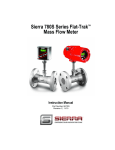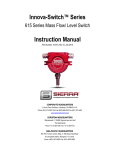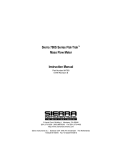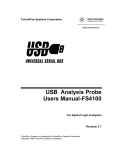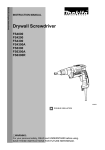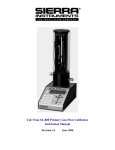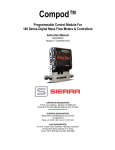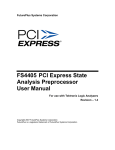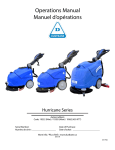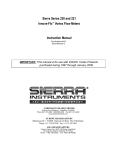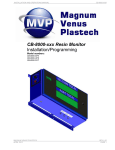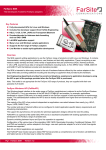Download Sierra 215 Switch User Manual
Transcript
INNOVA-SWITCH™ SERIES INSTRUCTION MANUAL Model 215 Mass Flow/Level Switch ( Model FS4200 Series – Mass Flow Switch / Model LS3200 Series – Point Level Switch ) Document IM 215 Rev-A.1 February 2006 Sierra Instruments, Inc., Headquarters 5 Harris Court, Building L Monterey, California, USA 93940 Toll Free: 800-866-0200 (USA only) Phone: 831-373-0200 ; Fax: 831-373-4402 Website: www.sierrainstruments.com Sierra Europe, European Headquarters Bijlmansweid 2 1934RE Egmond a/d Hoef The Netherlands Phone: +31 72 5071 400 ; Fax: +31 72 5071 401 Sierra Asia, Asia-Pacific Headquarters 100 Jaingnan Daidao Suite 2303 Guangzhou, China Phone: +86 20 3435 4870, Fax: +86 20 3435 4872 BEFORE STARTING SIERRA INSTRUMENTS appreciates your choosing our product for your liquid level or liquid/gas flow switching application. We are committed to providing reliable, quality instrumentation to our customers. To ensure the maximum and intended benefit of this instrument, we encourage you to read this brief operation and maintenance manual in its entirety prior to unpacking and installing the unit. The following precautions should be noted immediately: • WHEN INSTALLING YOUR INNOVA-SWITCH™ INTO A PIPE OR VESSEL USE A 1 1/8 INCH (28.575mm) OPEN-END WRENCH TO TIGHTEN AT THE HEX FLATS OF THE MNPT OF A STANDARD SWITCH. (IF YOU HAVE A NON-STANDARD SWITCH AN ALTERNATE SIZE WRENCH MAY BE REQUIRED). DO NOT USE THE INSTRUMENT HEAD TO TIGHTEN THE SWITCH TO THE MOUNTING PORT. ROTATION OF THE INSTRUMENT HEAD WITH RESPECT TO THE SENSOR BODY CAN CAUSE INTERNAL WIRING DAMAGE (SEE FIGURES 1). • THE SWITCH BODY MUST BE ORIENTED TO HAVE THE TWIN SENSORS PARALLEL TO THE LEVEL BEING DETECTED WHEN THE SENSOR IS INSTALLED HORIZONTALLY FOR POINT LEVEL APPLICATIONS. LIKEWISE, FOR FLOW APPLICATIONS, THE SWITCH BODY MUST BE ORIENTED TO HAVE THE TWIN SENSORS PERPENDICULAR TO THE FLOW BEING DETECTED. DUE TO THE PIPE THREAD MOUNTING, IT MAY BE NECESSARY TO MAKE A TRIAL FIT, ADD OR REMOVE TEFLON TAPE OR OTHER PIPE THREAD SEALANT, AND REINSTALL TO ACHIEVE A SATISFACTORY SEAL WITH THE SENSORS PROPERLY ORIENTED. FOR VERTICAL INSTALLATION OF SENSORS FOR POINT LEVEL DETECTION THE ORIENTATION MAKES NO DIFFERENCE. PROPER ORIENTATION IS MARKED ON THE SWITCH BODY FOR REFERENCE (SEE FIGURE 5). • A GROUND WIRE MUST BE ATTACHED TO THE GROUND SCREW LOCATED INSIDE THE INSTRUMENT ENCLOSURE FOR PROPER OPERATION. FOR CENELEC/CE OPTION THE GROUND SCREW IS LOCATED OUTSIDE THE BODY OF THE INSTRUMENT ENCLOSURE (SEE FIGURE 6). • BE SURE TO APPLY THE PROPER VOLTAGE AS CONFIGURED AT THE FACTORY. DO NOT APPLY 115 VAC TO 24 VDC VERSIONS OR 24 VDC TO 115 VAC VERSIONS. (LIKEWISE 230 VAC). • FOR OPTIMUM OPERATION, CALIBRATION MUST BE ACCOMPLISHED AT ACTUAL PROCESS TEMPERATURE AND PRESSURE CONDITIONS IN GASES AND AT ACTUAL PROCESS TEMPERATURE CONDITIONS IN LIQUIDS. • DO NOT SANDBLAST OR ABRASIVE CLEAN THE SENSING PROBES. PROBES COULD BE DAMAGED BY ABRASIVES. • ALL DIMENSIONS GIVEN IN THIS MANUAL ARE IN INCHES (AND MILLIMETERS). THE SENSING If you have any questions prior to or during installation and calibration, please do not hesitate to call the factory for assistance. We want to ensure the very best possible installation and operational results for your benefit. IM-215 Rev-A.1 Series Innova-Switch™ Page 2 of 42 NOTICE This manual covers the following model numbers: Innova-Switch™ Series Models 215 - FS4200 215 - LS3200 Agency Approvals Explosion-Proof rating Mass Flow Switch FS42CN Point Level Switch LS32CN CENELEC European EEX d IIB T4 (Killark Enclosure) EEx d IIC T4 (Akron Electric Enclosure) See Figure 1A and 1B CSA Canadian Standards T4A Class I, Group B,C,D Class II, Group E, F, G (Both Akron Electric and Killark) FS42CS LS32CS Non-Approved Non-Explosion Proof FS42NX LS32NX (Ref. Section CE 3.2.3 wiring) EMC Directive: 89/336/EEC Option-CE Option-CE SPECIAL NOTICE The electronic assemblies contained in the Innova-Switch™ models are configured for specific voltages and have specific modifications to accommodate the various agency approvals. When ordering spare electronics, replacements, or exchanges in the field please ensure you identify the specific configuration you have by noting the boxes marked on the transformer configuration tag. IM-215 Rev-A.1 Series Innova-Switch™ Page 3 of 42 TABLE OF CONTENTS 1.0 INTRODUCTION 2.0 DESCRIPTION 3.0 4.0 5.0 2.1 LEVEL SWITCHING 2.2 FLOW SWITCHING INSTALLATION 3.1 MECHANICAL INSTALLATION 3.2 ELECTRICAL INSTALLATION 3.2.1 LOCAL ELECTRONICS (LE OPTION/STANDARD) 3.2.2 REMOTE ELECTRONICS (RE) OPTION 3.2.3 CE OPTION FILTER BOARD CONNECTOR PLATE WIRING (CE OPTION) OPERATION AND CALIBRATION OF THE Innova-Switch™ SWITCH FOR FLOW APPLICATIONS 4.1 PRE-OPERATIONAL CHECKS 4.2 L.E.D. AND RELAY STATUS LOGIC (FAIL-SAFE) 4.3 CALIBRATION – FLOW OPERATION AND CALIBRATION OF THE Innova-Switch™ SWITCH FOR POINT LEVEL APPLICATIONS 6.0 5.1 PRE-OPERATIONAL CHECKS 5.2 L.E.D. AND RELAY STATUS LOGIC (FAIL-SAFE) 5.3 CALIBRATION – LEVEL MAINTENANCE AND TROUBLE SHOOTING 6.1 CLEANING 6.2 TROUBLE SHOOTING 6.2.1 POWER AND CONTINUITY VERIFICATION 6.2.2 SENSOR/ELECTRONICS FUNCTIONALITY VERIFICATION 7.0 SPECIFICATIONS 8.0 WARRANTY AND SERVICE 9.0 10 8.1 WARRANTY 8.2 SERVICE 8.3 SPARE PARTS LIST APPENDIX 9.1 VOLUME FLOW CONVERSION CHART 9.2 FLOW CONVERSION CHART 9.3 FLOW OF WATER THROUGH SCHEDULE 40 STEEL PIPE (AVAILABLE IN PRINTED MANUAL ONLY) OPTIONS 10.1 LIVETAP (LT) 10.2 VARIABLE INSERTION (VI) 10.3 THERMOCOUPLE OUTPUT (TO) 10.4 RTD OUTPUT(RT) 10.5 SANITARY (3A1) IM-215 Rev-A.1 Series Innova-Switch™ Page 4 of 42 1.0 INTRODUCTION ™ The SIERRA INSTRUMENTS Innova-Switch Switch is the state-of-the-art in gaseous and liquid flow switching or liquid level control. Flow or level detection is accomplished by using a high resolution thermal differential technique. The sensor wetted parts are of durable 316L series stainless steel, all welded construction with no moving parts. The switch is easy to install and adjust, giving reliable, low maintenance performance in the most demanding applications. 2.0 DESCRIPTION ™ The Innova-Switch uses a thermal differential technique to sense changes in the heat transfer characteristics of a media. Figures 1A and 1B show the outline of the ™ Innova-Switch . The sensor consists of a pair of matched Resistance Temperature Detectors (RTD's) encased in twin 316L series stainless steel tubes. One RTD is self-heated using a constant DC current. The other RTD is unheated to provide an accurate process temperature reference. The thermal differential created between the heated and reference RTD pair is a function of the density and/or velocity of the media with which the sensor is in contact. Other physical properties may have a secondary effect as well. The differential is greatest at a no flow (or dry) condition and decreases as the rate of flow increases (or as a liquid quenches the sensor/wet condition). The SIERRA INSTRUMENTS sensor excitation method relies on constant current to the heated and reference sensors. Thus power to the heated sensor is not constant but changes linearly with temperature as the sensor resistance changes. Temperature compensation is accomplished by using the amplified reference sensor voltage that also changes linearly with temperature, as a dynamic reference. During calibration dry/no flow and wet/full flow conditions are impressed across the trip point potentiometer. Since this reference is not fixed but is set with respect to the reference sensor voltage, as temperature changes the trip point potentiometer voltage changes with temperature exactly the same as that of the heated sensor voltage with which it is being compared. Thus full temperature compensation is achieved with non-constant power. IM-215 Rev-A.1 Series Innova-Switch™ Page 5 of 42 FIGURE 1A IM-215 Rev-A.1 LS3200/FS4200 Innova-Switch™ OUTLINE DIAGRAM STANDARD 2.0 INCH INSERTION (KILLARK ENCLOSURE – NEMA 4-EExd 11B, T4) Series Innova-Switch™ Page 6 of 42 FIGURE 1B IM-215 Rev-A.1 LS3200/FS4200 Innova-Switch™ OUTLINE DIAGRAM STANDARD 2.0 INCH INSERTION (AKRON ELECTRIC ENCLOSURE – NEMA 4X – EexdIIC, T4) Series Innova-Switch™ Page 7 of 42 2.1 LEVEL SWITCHING The thermal differential created between the heated and reference unheated RTD pair is a function of the liquid or gas medium with which the sensor is in contact. The point level measurement application uses the heat transfer differences between two media to detect liquid level. For example, air has a relatively poor heat transfer characteristic so the heated sensor will become relatively hot. If the sensor is then immersed in water, the relatively high heat transfer characteristics of water will cool the heated RTD surface causing a decrease in the signal output. This same rational applies for any two media in contact with the sensor. Each medium will have its own characteristic heat transfer properties. As long as there is a reasonable difference in the heat transfer properties between the two media, the Innova-Switch™ can discriminate between them. Figure 2A shows the relative signal output of the Innova-Switch™sensor to a range of different media. The maximum difference in output occurs between vacuum and liquid metal. However, a significant difference occurs between water and hydrocarbon liquids so the Innova-Switch ™ can be used to detect a water/hydrocarbon liquid-liquid interface. In general, the interface between any two media with differing heat transfer properties can be detected. Thermal Differential Theory of Operation Note: Probe tips contain matched RTD’s one of which is self-heated with about 400mw of power. The other provides temperature compensation. The heated RTD responds to the heat transfer coefficient of the media with which it is in contact. Gases with low heat transfer result in a high differential temperature between the heated and reference tips. IM-215 Rev-A.1 When the heated tip makes contact with a liquid with higher heat transfer the differential temperature drops and the lower differential results in a switch trip to indicate liquid. Series Innova-Switch™ Page 8 of 42 FIGURE 2A: RELATIVE CHANGE IN RESPONSE OF A HEATED RTD IMMERSED IN VARIOUS MEDIA 2.2 Flow Switching Most mass flow monitoring techniques calculate mass indirectly by measuring volumetric flow such as gallons per minute or cubic cm per second, then either measure density separately or calculate it from temperature measurements of the fluid and, finally, combine density and volumetric flow to obtain mass flow. The SIERRA INSTRUMENTS thermal-differential technique is one of two methods that directly measure the mass flow. For ease of comparison most flow applications are presented in terms of velocity which is independent of the flow cross sectional area (i.e. feet per second (FPS)). The true mass flow equivalent would be FPS multiplied by density but for simplicity FPS is used and density effects are ignored. This is normally not critical for flow switching applications. IM-215 Rev-A.1 Series Innova-Switch™ Page 9 of 42 When the sensor is inserted into a liquid or gas the heated RTD is strongly affected by the velocity of the medium. Flow past the heated RTD changes the heat transferred from the surface of the sensor. This cooling effect reduces the temperature of the sensor. The Innova-Switch™ compares this change to a preset flow trip point to switch the output. Figure 2B shows the model FS4200 signal change vs. flow rate for air, light hydrocarbon liquids, and water. The signal change vs velocity has the same general shape for all three media but the change is larger for air and the sensitive range is different for each. For air and most gaseous media the range is 0.1 to 500 feet per second (FPS). For most liquid media the range is 0.01 to 5 FPS. Appendices in section 9.0 contain flow conversion information to facilitate conversion from various units and pipe dimensions into flow velocity in feet per second. Gas Or Liquid Flow For a no flow condition the thermal differential between the two tips is high because of relatively low heat transfer. Note: The fluid velocity and heat absorption ability determine the differential between the tips. Their combination determines the measurable velocity. In water velocities from 0.01 to 5 FPS are measurable, whereas in air velocities of 0.1 to 500 FPS can be measured. When the lower differential matches the customer select flow velocity trip point (set point) the switch relay and red LED are tripped. IM-215 Rev-A.1 Flow across the tips decreases the thermal differential because of the higher heat transfer of flowing fluids. This differential is compared with the trip point. When flow is above the trip point the differential is smaller than at the set point and the relay and Led remain tripped. Series Innova-Switch™ Page 10 of 42 FIGURE 2B Innova-Switch™ MODEL FS4200 FLOW RESPONSE FOR THREE MEDIA IM-215 Rev-A.1 Series Innova-Switch™ Page 11 of 42 Figure 3.A shows a block diagram of the Innova-Switch™ switch. Once the switch is set to respond to the minimum and maximum flow rates (or wet vs. dry conditions), the trip point is set by adjusting the Trip Adjust Potentiometer. Solid state electronics transform the flow (or wetting) induced temperature differential into a voltage that is compared to a control voltage. Matching voltages cause actuation of a relay to indicate a change in state (flow vs. no-flow or dry vs. wet). FIGURE 3A: IM-215 Rev-A.1 Innova-Switch™ SERIES S BLOCK DIAGRAM MODELS LS32CS/FS42CS, LS32CN/FS42CN, LS32NX/FS42NX Series Innova-Switch™ Page 12 of 42 Figure 3B shows a block diagram of the Innova-Switch™ with the addition of an EMC filter required for the CE options (see section 7.0). FIGURE 3B: Innova-Switch™ MODELS WITH THE CE OPTION SWITCH BLOCK DIAGRAM IM-215 Rev-A.1 Series Innova-Switch™ Page 13 of 42 The instrument enclosure at the top of unit contains the Innova-Switch™ electronics board which is removable to access the terminal block and facilitate field wiring (see Figure 4.0). For applications where the electronics must be located away from the sensors due to elevated process temperature, accessibility, etc., another instrument head containing the electronics is remotely located (See option RE-Remote Electronics section 3.2.2). FIGURE 4 IM-215 Rev-A.1 Innova-Switch™ SWITCH ASSEMBLY Series Innova-Switch™ Page 14 of 42 3.0 Installation 3.1 Mechanical Installation The standard Innova-Switch™ has a .75 inch (19.05mm) MNPT mount designed for easy installation through a threaded port. Optional configurations include .5” (12.7mm) or 1.0” (25.4mm) MNPT and flange mounts. Conduit is recommended for all wiring to the switch. *IMPORTANT* WHEN INSTALLING YOUR SIERRA INSTRUMENTS SWITCH INTO A PIPE OR VESSEL USE A 1 1/8 INCH (28.575mm) OPEN-END WRENCH TO TIGHTEN AT THE HEX FLATS OF THE MNPT OF A STANDARD SWITCH. (IF YOU HAVE A NON-STANDARD SWITCH AN ALTERNATE SIZE WRENCH MAY BE REQUIRED). DO NOT USE THE INSTRUMENT HEAD TO TIGHTEN THE SWITCH TO THE MOUNTING PORT. ROTATION OF THE INSTRUMENT HEAD WITH RESPECT TO THE SENSOR BODY CAN CAUSE INTERNAL WIRING DAMAGE. *IMPORTANT* THE SWITCH BODY MUST BE ORIENTED TO HAVE THE TWIN SENSORS PROPERLY ORIENTED. DUE TO THE PIPE THREAD MOUNTING, IT MAY BE NECESSARY TO MAKE A TRIAL FIT, ADD OR REMOVE TEFLON TAPE OR OTHER PIPE THREAD SEALANT, AND REINSTALL TO ACHIEVE A SATISFACTORY SEAL WITH THE SENSORS PROPERLY ORIENTED. PROPER ORIENTATION IS MARKED ON THE SWITCH BODY FOR REFERENCE. SEE FIGURE 5.0 FOR DETAILS. IM-215 Rev-A.1 Series Innova-Switch™ Page 15 of 42 FIGURE 5: IM-215 Rev-A.1 PROPER ORIENTATION OF THE SENSOR PROBE FOR LEVEL AND FLOW APPLICATION IS INDICATED BY THE ARROW ON THE FLAT OF THE MOUNTING FITTING. Series Innova-Switch™ Page 16 of 42 3.2 Electrical Installation 3.2.1 CE Option Filter Board Connector Plate Wiring (CE Option) Remove the instrument enclosure lid by unscrewing in a counter clockwise direction. Unscrew (CCW) the printed circuit board captive screws (See Figure 4.0 for locations). Remove the PC board by grasping the transformer and pulling it straight out. Connect power and alarm relay wiring to Terminal Block (TBB) as shown in Figures 6.0 and 6.0A. Reinstall the Innova-Switch™ Switch electronics and tighten the captive screws. FIGURE 6.0 Innova-Switch™ SWITCH LOCAL ELECTRONICS FIELD WIRING DIAGRAM NOTES: 1. Connections to sensors terminal block A (TBA) are factory installed and should not be disconnected in the field. Note Jumpers 1-2, 3-4, and 5-6 must be in place on TBA for proper operation of local electronics. 2. For 24 VDC operation (factory prepared), connect +positive to TBB7 and –negative return to TBB8. For 115 VAC or 230 VAC connect hot to TBB7 and neutral to TBB8. 3. Connect ground wire to ground screw located in or on the instrument enclosure. 4. Use supply wires suitable for 10 Degrees C above ambient. *IMPORTANT* A GROUND WIRE MUST BE ATTACHED TO THE GROUND SCREW LOCATED INSIDE OR OUTSIDE OF THE INSTRUMENT ENCLOSURE FOR PROPER OPERATION. 3.2.2 Remote Electronics (RE Option) For the remote electronics option, mount the remote instrument head using two IM-215 Rev-A.1 Series Innova-Switch™ Page 17 of 42 mounting wings or bracket provided. Connect the switch wiring between the InnovaSwitch™ Switch remote electronics as shown in Figure 7.0. Connect power wiring and alarm relay wiring to the remote enclosure as shown in Figure 7.0. Upon completion of wiring reinstall the Innova-Switch™ electronics and secure with the captive screws. *IMPORTANT* BE SURE TO APPLY THE PROPER VOLTAGE AS CONFIGURED AT THE FACTORY. DO NOT APPLY 115 VAC TO 24 VDC VERSIONS OR 24 VDC TO 115 VAC VERSIONS (LIKEWISE 230 VAC). SPECIAL NOTICE The electronic assemblies contained in the Innova Switch™ are configured for specific voltages and have specific modifications to accommodate the various agency approvals. When ordering spare electronics, replacements, or exchanges in the field please ensure you identify the specific configuration you have by noting the boxes marked on the transformer configuration tag and the serial number. IM-215 Rev-A.1 Series Innova-Switch™ Page 18 of 42 IM-215 Rev-A.1 Series Innova-Switch™ Page 19 of 42 FIGURE 7A WIRING Innova Switch FLOW SWITCH REMOTE ELECTRONICS OPTION FIELD IM-215 Rev-A.1 Series Innova-Switch™ Page 20 of 42 FIGURE 7B REMOTE ELECTRONICS CABLE TERMINATION AND CONNECTIONS 3.2 Electrical Installation 3.2.3 CE Option Filter Board Connector Plate Wiring (CE Option) Remove the instrument enclosure lid by unscrewing in a counter clockwise direction. Unscrew (CCW) the printed circuit board captive screws (See Figure 4.0 for locations). Remove the PC board by grasping the transformer and pulling it straight out. Connect power and alarm relay wiring to Terminal Block (TBB) as shown in Figures 6.0 and 6A. Reinstall the Innova-Switch™ Switch electronics and tighten the captive screws. POWER RELAY CONTACTS GNDEARTH CAUTION:Usesupply wires suitable for 10°Cabovesurroundingambient. TBB N H - + POWER C N N O C REL1-1 C N N O C DM#101654 REL1-2 REMOTE ELECTRONICS FILTER CONN PLATE (CE OPTION) TBA 1 2 3 4 5 6 SHIELDS CONNECTED TO TERMINAL 5 AT THIS END 3 TWISTED SHIELDED PAIRS CABLE SHIELDS FLOATING AT THIS END 1 2 3 4 5 6 HOT SENSOR FIGURE 6A COLD SENSOR REMOTE PROBE Innova-Switch™ SWITCH REMOTE ELECTRONICS FIELD WIRING DIAGRAM NOTES: 1. Connections to sensors terminal block A (TBA) are factory installed and should not be disconnected in the field. Note Jumpers 1-2, 3-4, and 5-6 must be in place on TBA for proper operation of local electronics. 2. For 24 VDC operation (factory prepared), connect +positive to TBB7 and – negative return to TBB8. For 115 VAC or 230 VAC connect hot to TBB7 and neutral to TBB8. 3. Connect ground wire to ground screw located in or on the instrument enclosure. 4. Use supply wires suitable for 10 Degree C above ambient. *IMPORTANT* A GROUND WIRE MUST BE ATTACHED TO THE GROUND SCREW LOCATED INSIDE OR OUTSIDE OF THE INSTRUMENT ENCLOSURE FOR PROPER OPERATION. IM-215 Rev-A.1 Series Innova-Switch™ Page 21 of 42 4.0 OPERATION AND CALIBRATION OF THE Innova-Switch™ FS4200 SWITCH FOR FLOW APPLICATIONS 4.1 Pre-Operational Check With the switch installed and process conditions at no-flow, the following procedure can be used to verify preliminary operation. 4.1.1 Remove the instrument enclosure cover by turning counter clockwise (ccw) to expose the Innova-Switch™ Switch electronics. 4.1.2 Turn on power at its source. 4.1.3 Observe that either the red or green LED comes on. 4.1.4 If neither lamp illuminates refer to the trouble shooting Section, 6.2. 4.2 L.E.D. and Relay Status Logic (Fail-safe) 4.2.1 The L.E.D.s (Red; Green) are an indication of the sensors status (ie. flow below the setpoint or flow above the set point) and are not affected by the position of the failsafe jumper J-2. The failsafe jumper J-2 changes the relay activation status allowing the user to select the failsafe power off condition most appropriate to the application. Refer to the tables below that show the logic conditions between the sensors, L.E.D. lights, relay coil and contacts for each position of the failsafe jumper J-2. 4.2.2 Normal Operation (as set at factory) The switch comes configured from the factory with the following operation with the J-2 jumper in the B(2-3) position. (Refer to Figure 8.0.) SENSOR STATUS RED LED GREEN RELAY LED COIL STATUS No Flow or Flow Below Set Point ON OFF RELAY CONTACT STATUS o NC Activated o NO o NC Flow or Flow Above Set Point OFF ON Deactivated o NO IM-215 Rev-A.1 Series Innova-Switch™ Page 22 of 42 FIGURE 8.0 4.2.3 Innova-Switch™ ELECTRONICS Alternate Operation (Field Selectable) The relay logic may be reversed by moving the J-2 jumper to position A(1-2). (Refer to Figure 8.0.) SENSOR STATUS RED LED GREEN RELAY LED COIL STATUS No Flow or Flow Below Set Point ON OFF RELAY CONTACT STATUS o NC Deactivated o NO o NC Flow or Flow Above Set Point OFF ON Activated o NO IM-215 Rev-A.1 Series Innova-Switch™ Page 23 of 42 FIGURE 9.0 4.3 Innova-Switch™ FS4200 FLOW SWITCHCALIBRATION REFERENCE DRAWING Calibration – Flow **IMPORTANT** FOR OPTIMUM OPERATION, CALIBRATION MUST BE ACCOMPLISHED IM-215 Rev-A.1 Series Innova-Switch™ Page 24 of 42 AT ACTUAL PROCESS TEMPERATURE AND PRESSURE CONDITIONS IN GASES AND AT ACTUAL PROCESS TEMPERATURE CONDITIONS IN LIQUIDS. See Figures 8.0 and 9.0 for location of potentiometers and LEDS on electronics PCB. 4.3.1 Calibration Procedure for Flow Switches 1. Remove the instrument enclosure lid by turning ccw. 2. Apply power to FS4200. Allow 5 minute warm-up. 3. Ensure that the pipeline is filled with fluid and at no or minimum flow. 4. Set the trip adjust pot to zero fully counterclockwise (fully ccw). 5. Adjust the zero adjust pot so that the Red LED just does illuminate. This is a 25 turn pot. If the Green LED is on, turn the pot ccw. If the Red LED is on, turn the pot clockwise (cw). 6. Toggle the zero adjust pot back and forth until the switching point is well defined. Leave the Red LED illuminated. 7. Adjust the liquid or gas flow to maximum velocity. Insure that the flow is homogenous, constant and free of bubbles if a liquid. **NOTE** The flow rate (maximum) should be at least 5 fps (liquid) or 500 fps (gas) if possible for best calibration. 8. Set the trip adjust pot to 100 (fully cw). 9. Adjust the span adjust pot so that the Green LED just does illuminate. This is a 25 turn pot. If the Green LED is on, turn the pot cw. If the Red LED is on, turn the pot ccw. 10. Toggle the span adjust pot back and forth until the switching point is well defined. Leave the Green LED illuminated. 11. If the switch is to be used for flow - no flow, set the trip adjust pot to 50 and go to step 14. (Note: This adjustment can be set for tripping points between 10% and 90% of the span from no flow to max flow). 12. A more exact flow rate setting may be made by establishing the flow at the desired rate with a separate flow meter and proceeding to step 13, to establish the trip point. 13. Adjust the trip adjust pot to obtain a trip as exhibited by an LED illumination. If a trip on decreasing flow is desired set for Red LED illumination. If a trip on increasing flow is desired set for Green LED illumination. 14. Verify that the switch will reset by returning the actual product flow to the maximum or minimum flow rates. 5.0 OPERATION AND CALIBRATION OF THE Innova-Switch™ SWITCH FOR POINT LEVEL APPLICATIONS 5.1 Pre-Operational Check LS3200 SERIES The switch is installed and the product level is below sensor level (dry), the IM-215 Rev-A.1 Series Innova-Switch™ Page 25 of 42 following procedure can be used to verify preliminary operation. 1. Remove the instrument enclosure cover by turning counter clockwise to expose the LS3200 Switch electronics. 2. Turn on power at its source. 3. Observe that either the red or green LED comes on. 4. If neither lamp illuminates refer to the trouble shooting Section, 6.2. 5.2 L.E.D. and Relay Status Logic (Fail-Safe) 5.2.1 The L.E.D.s (Red and Green) are an indication of the sensors status (ie. dry or wet) and are not affected by the position of the fail-safe jumper J-2. The fail-safe jumper J2 changes the relay activation status allowing the user to select the fail-safe power off condition most appropriate to the application. Refer to the tables below that show the logic conditions between the sensors, L.E.D. lights, relay coil and contacts for each position of the fail-safe jumper J-2. 5.2.2 Normal Operation (as set at factory) The switch comes configured from the factory with the following operation with the J-2 jumper in the B (2-3) position. (Refer to Figure 8.0.) RED LED GREEN LED RELAY COIL STATUS Dry, or Lower Thermal Dispersion Fluid (ie. hydrocarbons) ON OFF Activated Wet, or Higher Thermal Dispersion Fluid (ie. water) OFF SENSOR STATUS 5.2.3 RELAY CONTACT STATUS o NC o NO ON o NC Deactivated o NO Alternate Operation (Field Selectable) The relay logic may be reversed by moving the J-2 jumper to position A(1-2). (Refer to Figure 8.0.) SENSOR STATUS RED LED Dry, or Lower Thermal ON GREEN LED RELAY COIL STATUS RELAY CONTACT STATUS o NC IM-215 Rev-A.1 OFF Series Innova-Switch™ Deactivated Page 26 of 42 Dispersion Fluid (ie. hydrocarbons) o NO o NC Wet, or Higher Thermal Dispersion Fluid OFF ON Activated o NO (ie. water) See Page 26 For Fuse Value FIGURE 8.0 5.3 Innova-Switch™ ELECTRONICS Calibration – Level **IMPORTANT** FOR OPTIMUM OPERATION CALIBRATION MUST BE ACCOMPLISHED AT ACTUAL PROCESS TEMPERATURE CONDITIONS. IM-215 Rev-A.1 Series Innova-Switch™ Page 27 of 42 FIGURE 10.0 Innova-Switch™ LS3200 POINT LEVEL SWITCH CALIBRATION REFERENCE DRAWING 5.3 Calibration - Level Using Figure 10.0 as a location guide adjust the system as follows: 1. Remove the instrument enclosure lid by turning ccw. 2. Apply power to the unit. Allow 5 minute warm-up. 3. For optimum calibration results, wet sensor and drain but do not dry. 4. Ensure that the tank liquid level is below the probe sensor tips. IM-215 Rev-A.1 Series Innova-Switch™ Page 28 of 42 5. Set the trip adjust pot to zero, fully counterclockwise (fully ccw). 6. Adjust the zero adjust pot so that the Red LED just does illuminate. This is a 25 turn pot. If the green LED is on, turn the pot counterclockwise (ccw). If red LED is on, turn the pot clockwise (cw). 7. Toggle the zero adjust pot back and forth until the switching point is well defined. Leave the Red LED illuminated. 8. Raise the level of the liquid to be detected until the probe/sensor tips are submerged and wet (covered). 9. Set the trip adjust pot to 100 (fully cw). 10. Adjust the span adjust pot so that the Green LED just does illuminate. This is a 25 turn pot. If the Green LED is on, turn the pot cw. If the Red LED is on, turn the pot ccw. 11. Toggle the span adjust pot back and forth until the switching point is well defined. Leave the green LED illuminated. 12. Adjust the trip adjust pot to 80 and the calibration is complete. Setting this pot to 80 gives an approximate equal trip time from wet to dry and from dry to wet. Setting this pot closer to zero will speed up dry to wet trip time and slow down wet to dry trip time. Setting this pot closer to 100 will slow down the dry to wet trip time and speed up wet to dry trip time. IM-215 Rev-A.1 Series Innova-Switch™ Page 29 of 42 6.0 INTENANCE AND TROUBLE SHOOTING 6.1 Cleaning The switch can be cleaned by soaking, spraying solvents or detergent-and-water onto the sensor tubes, or by ultrasonic cleaning. Lime deposits can be safely removed by soaking in 20% hydrochloric acid. Warming to 150°F is permissible to speed this process. The acid must be thoroughly rinsed off once cleaned. For unusual cleaning problems, call SIERRA INSTRUMENTS and determine the exact materials of construction and chemical compatibility before using strong acids or unusual cleansers. **IMPORTANT** DO NOT SANDBLAST OR ABRASIVE CLEAN THE SENSING PROBES. THE SENSING PROBES COULD BE DAMAGED BY ABRASIVES. 6.2 Troubleshooting 6.2.1 Power and Continuity Verification 1. Turn power off to the Innova-Switch™. 2. Remove the instrument enclosure cover (ccw). 3. Loosen the two PC captive screws (see Figure 4.0 for location). 4. Unplug the PC board from the instrument enclosure by pulling straight out on the transformer. 5. Reapply power and verify correct voltage at pins 7 (positive for DC) and 8 (negative for DC) of TBB (see Figures 6.0 or 7.0). 6. If voltage is correct, verify the fuse (F1) on the PC board is not blown (See Figure 8.0). If fuse is not blown proceed to 6.2.2. 7. If fuse is blown replace with appropriate value (See 7.0 Specification). IM-215 Rev-A.1 Series Innova-Switch™ Page 30 of 42 6.2.2 Sensor/Electronics Functionality Verification 1. Turn power off to Innova-Switch™. 2. Allow a 5 minute cool down. 3. Measure the resistance of each RTD at pins 1 and 6 of TBA (see Figure 6.0 or 7.0) for the hot RTD and pins 3 and 5 of TBA for the cold RTD. These resistances should be 110 ± 10 ohms (with sensors at approximately 70°F) and within 5% of each other in value. 4. Measure the insulation resistance between pin 1 of TBA and the case of the Innova-Switch™. It should greater than 20 megohms. 5. If the Innova-Switch™ sensor assembly resistances are not as specified above, the switch sensor assembly must be replaced. 6. If the Innova-Switch™ sensor assembly resistances are as specified, the InnovaSwitch™ PC electronic board must be replaced. SPECIAL NOTICE The electronic assemblies contained in the Innova-Switch™ are configured for specific voltages and have specific modifications to accommodate the various agency approvals. When ordering spare electronics, replacements, or exchanges in the field please ensure you identify the specific configuration you have by noting the boxes marked on the transformer configuration tag. IM-215 Rev-A.1 Series Innova-Switch™ Page 31 of 42 7.0 SPECIFICATIONS TYPE: Thermal Differential-Dual RTD Sensors PROCESS CONNECTIONS: 0.75” (19.05mm) MNPT Standard, 0.5"(12.7mm), 1" (25.4mm) MNPT, and various flanges optional. INSERTION LENGTH: Two inch (50.8mm) Standard, (shorter 0.5 inch (12.7mm) and longer to 120 inch (3048mm) optional). CONSTRUCTION MATERIALS: Wetted parts are 316L SS welded construction (alternate materials for corrosive environments available as options. Consult factory.) AGENCY INSTRUMENT RATINGS: CSA Explosion Proof: (CS series) T4A Class I, Group B, C, and D Class II, Group E, F, and G CENELEC/Explosion Proof (CN Series): EEx d IIC T4(Akron Electric Enclosure) EEx d IIB T4(Killark Enclosure) CE: EMC Directive: 89/336/EEC (CE Option) OPERATING TEMPERATURE: Process: -70°C to + 200°C (-100°F to +390°F) standard (to + 600°C (+1000°F) optional Electronics: -40°C to +60°C (-40°F to +140°F) PRESSURE RATED: To 3000 psig (20.4 MPa) RANGE Gaseous Mass Flow: 0.1 to 500 fps Liquid Mass Flow: 0.01 to 5 fps REPEATABILITY: ± 1% of Set Point or ± 1/32 inch (±.8mm) TIME RESPONSE: 0.5 to 10 seconds no-flow (dry) to flow (wet) and 2 to 60 seconds flow (wet) to no-flow (dry) (application dependent) INPUT POWER: 115 Vac, 50/60HZ standard. (230 Vac, 50/60HZ, 24 Vdc, or 24 Vac optional); 3.1w. maximum. SIERRA INSTRUMENTS PART NO. FUSE REQUIREMENTS (F1): CSA/FM CENELEC 115 Vac: 1/4 amp 101603 101605 230 Vac: 1/4 amp 101603 101605 24 Vdc: 1/4 amp 101603 101605 OUTPUT: 5A, 250 VAC, DPDT Standard (Optional 10A, 250 Vac SPDT) 5A 30 VDC STABILITY: Temperature compensated over entire range. IM-215 Rev-A.1 Series Innova-Switch™ Page 32 of 42 8.0 WARRANTY AND SERVICE 8.1 Warranty SIERRA INSTRUMENTS Corporation warranties Innova-Switch™ switches for a period of two years from the date of shipment and will repair or replace this product in the event of a defect in materials or workmanship. To have a product repaired, it should be returned at customer's expense, after obtaining return authorization as described in Section 8.2, to a repair facility designated by SIERRA INSTRUMENTS and, after repair, SIERRA INSTRUMENTS will prepay transportation to return the product to the customer. This limited warranty only covers failures due to defects in materials or workmanship which occur during normal use. LIMITS AND EXCLUSIONS SIERRA INSTRUMENTS SHALL NOT BE LIABLE FOR INCIDENTAL OR CONSEQUENTIAL DAMAGES (INCLUDING, BUT NOT LIMITED TO, LOSS OF USE, LOSS OF SALES, OR INCONVENIENCE) RESULTING FROM THE USE OF THESE PRODUCTS, OR ARISING OUT OF ANY BREACH OF THIS WARRANTY. EXCEPT AS SET FORTH ABOVE, THERE ARE NO EXPRESS OR IMPLIED WARRANTIES OR WARRANTIES OF MERCHANTABILITY OR FITNESS FOR A PARTICULAR PURPOSE. 8.2 Service To receive prompt service call SIERRA INSTRUMENTS's Customer Service Dept. (831) 373-0200 or toll free 1-800-866-0200. A representative will assist you in determining if the unit must be returned to the factory. A Return MAterials Authorization Number (RMA) will be given and should clearly mark the outside of the returning package. Prior to calling, be sure to have the model number and serial number information for quick identification and service response. IM-215 Rev-A.1 Series Innova-Switch™ Page 33 of 42 8.4 Spare Parts List Part No. Description Innova-Switch Electronics 200203.1 FS42/LS32 – 110Vac 200203.2 FS42/LS32- 24Vdc 200203.3 FS42/LS32 - 220Vac 200203.5 FS42/LS32 w/ HS Relay (Specify Voltage) 200540.1 FS4100/LS3100 -110Vac 200540.2 FS4100/LS3100 - 24Vdc 200540.3 FS4100/LS3100 - 220Vac Connector Plates 200202 FS42/LS32 –Local Electronics 200450 Remote Connector Plate 200182 Remote – MT & HT Options Fuses 101603 101605 FS42/LS32 - Wickmann 3740250041 FS42/LS32-Cenelec Wickmann 3720250041 Manuals IM 4200 Innova-Switch Manual Enclosures 101790 101797 101798 101611 101612 101613 Standard Enclosure Standard Enclosure w/ Cenelec Approval Standard Enclosure w/ Glass Window Enclosure for Failure Alarm Option-Std. Enclosure for Failure Alarm Option – Cenelec Enclosure for Failure Alarm Option-Glass Window Cable 101567 101539 Cable- Standard Cable- MT/HT Option Sensor 200711 200087 N/A N/A Sensor Assy. .75-S6-2.00 Sensor Assy. 1.00-S6-2.00 Sensor Assy. .50-S6-2.00 Other determined by original part no. IM-215 Rev-A.1 Series Innova-Switch™ Page 34 of 42 9.1 VOLUME FLOW CONVERSION CHART Convert known units to cubic feet per second (CFPS) or gallons per minute (GPM) for use with Chart A.2 TO CONVERT FROM TO MULTIPLY BY Gallons Per Minute (GPM) Cubic Feet Per Per Second (CFPS) 2.228 E-03 Gallons Per Day (GPD) CFPS 1.547 E-06 Barrels Per Day (BPD) CFPS 6.531 E-5 Cubic Ft. Per Minute (CFPM) CFPS 1.667 E-02 Cubic In. Per Minute (CIPM) CFPS 9.645 E-06 Milliliters Per Minute (MLPM) CFPS 5.886 E-07 Milliliters Per Second (MLPS) CFPS 3.531 E-05 Milliliters Per Hour (MLPH) CPFS 9.810 E-09 Liters Per Day (LPD) CPFS 4.087 E-07 Gallons Per Day (GPD) GPM 6.944 E-04 Barrels Per Day (BPD) GPM 2.931 E-02 Cubic Ft. Per Second (CFPS) GPM 4.488 E+02 Cubic Ft. Per Minute (CFPM) GPM 7.481 Cubic In. Per Minute (CIPM) GPM 4.329 E-03 Milliliters Per Minute (MLPM) GPM 2.642 E-04 Milliliters Per Second (MLPS) GPM 4.403 E-06 Milliliters Per Hour (MLPH) GPM 1.585 E-02 Liters Per Day (LPD) GPM 1.835 E-04 IM-215 Rev-A.1 Series Innova-Switch™ Page 35 of 42 9.2 IM-215 Rev-A.1 FLOW CONVERSION CHART Series Innova-Switch™ Page 36 of 42 9.3 FLOW OF WATER THROUGH SCHEDULE 40 STEEL PIPE IM-215 Rev-A.1 Series Innova-Switch™ Page 37 of 42 10.0 10.1 IM-215 Rev-A.1 OPTIONS LIVETAP (LT) Series Innova-Switch™ Page 38 of 42 10.2 IM-215 Rev-A.1 VARIABLE INSERTION (VI) Series Innova-Switch™ Page 39 of 42 10.3 IM-215 Rev-A.1 THERMOCOUPLE OUTPUT (TO) and 10.4 RTD OUTPUT (RT) Series Innova-Switch™ Page 40 of 42 IM-215 Rev-A.1 Series Innova-Switch™ Page 41 of 42









































